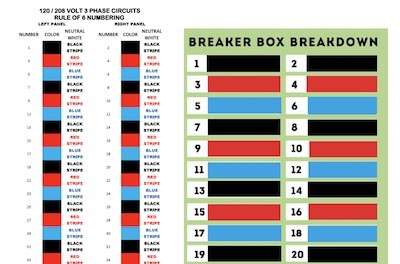The Rule of 6 & Branch circuits for Electrical Professionals

One thing we as manufacturers for products used by electrical contractors and electricians is to look for are products and processes that can be standardized. Standardization means better preplanned production, which means less labor and higher volume which translates into lower prices for electrical contractors and electricians from us.
One of the standards for the electrical industry is the 3-Phase circuit color codes. For low/medium voltage, black, red, and blue wires with an identifiable matching neutral is the rule. For high voltage (HV), it is brown, orange and yellow wires and again with an identifiable matching neutral. At this point, the numbering sequences can vary from electrical contractor to electrical contractor. One contractor may just label the wires as #1-6 with the first two black wires numbered #1 and #2, and the two red wires #3 and #4, and the two blue wires #5 and #6 and the six whites phase striped (2 striped black, 2 striped red, 2 striped blue). A different electrical contractor may have them alternating so the first black wire is #1, red wire #2, Blue wire #3, and second of each are #4, #5, #6 respectively and the whites are numbered as well #1-6 so they can be paired. The third may ask for two reds #28, and #33, two blues #29 and #30, and two black #31 and #32, with the neutral whites to be phased, striped, and numbered accordingly. While another electrical contractor may ask for two 3 circuit pulls, one marked with “odds” and the other marked with “evens” and each containing a black, red, blue conductor and a matching neutral.
Three of these four examples are using a standardized rule for 3 phase circuits. In a standard three phase circuit, the three phases are listed as “A”, “B”, and “C” in a Panel. The left side and right side both have these phases, therefore Phase A on the left is Circuit 1, and Phase A on the right is Circuit 2, Phase B on the left is Circuit 3 and on the right Circuit 4, and Phase C is Circuit 5 on the left and Circuit 6 on the right.
Now if you standardize the colors of the three phases so they are always the same, Phase A will always be black, Phase B will always be red, and Phase C will always be blue. Most electrical contractors generally accept this principle and very rarely do we see the 6 circuits requested in a single color. However, we still see a lot of requests similar to this where the phase lines are broken down by the generally accepted colors of black, red, and blue, which are then numbered sequentially 1 through 6 so there are not two conductors of black both number 1.
So the electrical industry has standardized itself into two camps: one uses the sequential method discussed above, and the second (which comprises the majority) uses what is known as the “Rule of 6.”
In commercial 120/208-volt medium voltage and 277/480-volt high voltage electrical systems, there are three phases – A, B, and C. Each phase is one of three colors – black, red, or blue for low and medium voltage and Brown, Orange, Yellow for high Voltage. Each phase gets a matching neutral circuit (although in rare occurrences a circuit may share a neutral). For low and medium voltage, the circuits use a white conductor for the neutral and high voltage circuits. Phase A is circuit 1 and 2 (black), Phase B is circuit 3 and 4 (red), Phase C is circuit 5 and 6 (blue). It then starts over with the phases. Phase A is circuit 7 and 8 (black) and on down the line. Phase A circuits are always black wire. Phase B circuits are always red wire. Phase C circuits are always blue wire. Seems easy enough to remember. This is where the name the “rule of 6″ was developed.
Each multiple of 6 is always blue: 6, 12, 18, 24, 30, 36, 42, 48, 54, 60. The request for #1,and #2 in black, #3 and #4 in red, and #5 and #6 in blue, fall into this rule. As for the one that was continuing to the next panel with the two blues #29 and #30, it is still the Rule of 6. #30 is divisible by 6 and take away one we have #29. A great feature of this rule is that the electrician does not have to remember all these numbers or which ones are odd and which ones are even. All the electrical professional needs to remember is blue is a multiple of 6 along with the color pattern black, red, blue. Once the electrical worker knows this, then it becomes easy to figure out the other circuit colors by finding the closest multiple of 6 and backtracking.
For example, if you had to pull wire for circuit 27, you would find the closest multiple of 6, which is 30. Since 29 and 30 are both blue, it means that 27 and 28 are both red, so the color wire needed to install for circuit 27 would be red. This works regardless of the conductor number. If electrical contractors simplify their numbering to match the slots in the electrical panels in which the branch circuits are installed, one will notice the numbering on the left are odds, and the right evens.
If a panel has 42 slots there are 21 circuits on each side and 7 complete phase lines available. This means a factory can standardize configurations of bundled cable up to 42 circuits, allowing a limited stock available which then just need to be cut to length and shipped after receiving the order. This helps mark clearly the panel box for each reel so #41 for panel 1 is not confused with #41 for panels, 2, 3, 4 and so on.
However, until then we will happily customize every bundled cable order to fulfill whatever needs our customers have.
Have a look at our article on 8 Steps Pulling wire through conduit.

READY TO SAVE TIME & MONEY WITH BUNDLED CABLE?
Get a quote on our custom cable bundles today.


